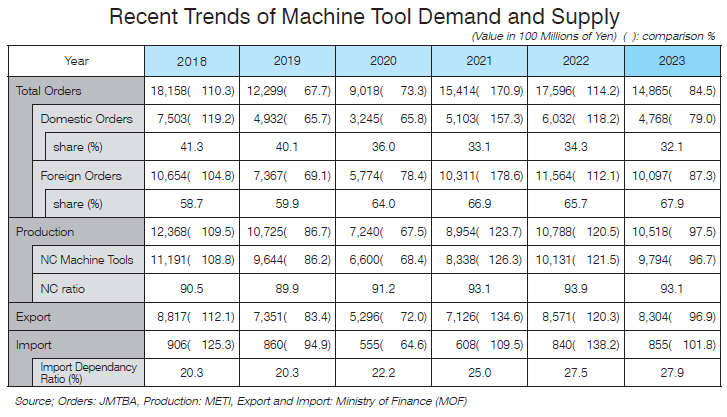Progress of Japan’s Machine Tool Industry
Japanese machine tool manufacturers took a keen early interest in the applied development of NC (numerical control) technology, which was developed in the United States in the first half of the 1950s. As a result of having aggressively introduced NC technology, Japan quickly achieved further development of the technology. By the late 1970s, world markets had already come to appreciate the performance of Japanese NC machine tools. And by riding the growing wave of the mainstreaming of NC machine tools, Japan took over in 1982 as the world leader in the production volume of NC machine tools, which till then had been led by the United States, after that, Japan held that position for 27 consecutive years. Since 2009, China has become the world’s largest producer, and Japan continues to compete with Germany for the second place, but due to its high technical level, production capacity, and detailed after-sales service, it has become highly reliable in Japanese machine tools. Japan is considered to be a major manufacturer of machine tools.
Looking back on the history of Japan’s machine tool industry in terms of production trends, from 1988 to 1994, production rapidly increased against the backdrop of strong domestic demand, and in 1990 it reached a record high of 1,303.4 billion yen. Although it was the highest amount in our history, production dropped sharply due to the collapse of the bubble economy.
From 2003 to 2009, total production value increased to 1,303.2 billion yen in 2007, due to renewal market during the booming period of 1990 and the revival of heavy industries in domestic demand, and the rise of the Chinese manufacturing industry and the overseas expansion of Japanese companies in external demand. Although the amount increased, due to the Lehman shock, production dropped sharply to 486.3 billion yen in 2009, the level of about 30 years ago.
In the development since 2013, against the backdrop of the rise of emerging economies and the trend toward higher added value and efficiency, the demand increased significantly centered on smartphone manufacturing by electronic equipment manufacturing contract service (EMS), semiconductor manufacturing equipment following the development of IoT and the automobile industry, which focuses on fuel efficiency regulations and development of next-generation vehicles and the production generally remained at a high level.
In recent years, disturbance factors such as intensifying trade friction between the United States and China, frequent occurrence of natural disasters in Japan, and the global epidemic of the new coronavirus infection have greatly affected the increase and decrease in production, and the shortage of parts is currently a hindrance to production.
Turning to trade, imports greatly exceeded exports for a while during the post-war period because domestic machine tools did not at first have adequate supply channels or technological capabilities. But exports rose sharply starting from the 1960s, when domestic machine tools began showing competitive edges. Exports finally topped imports in 1972. Looking at export destinations, until the 1980s, exports were mainly to Europe and North America, but since 2000, exports to Asia account for 40 to 50%.


CONNECT WITH US: LinkedIn , Facebook, Twitter










